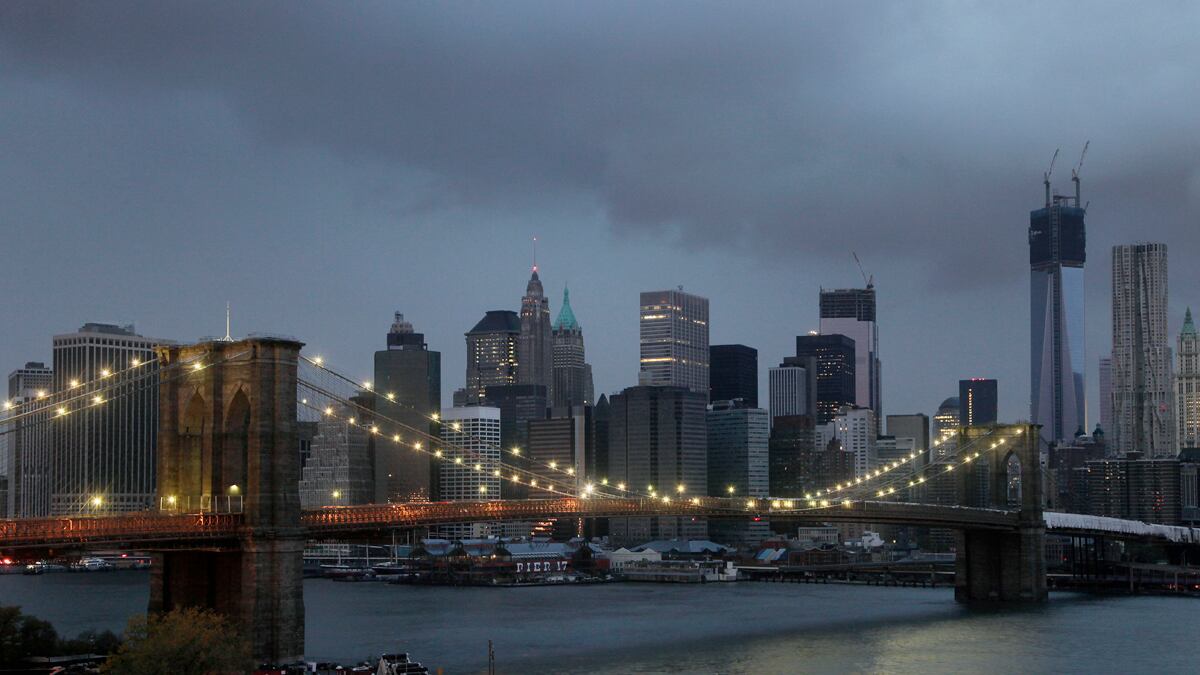8:34 p.m.
That is when Auria Adams said she looked out her window in the Lillian Wald Houses on East 6th Street and FDR Drive. She saw a brilliant flash of light, an explosion, at the Con Ed plant about nine blocks north in the East Village.
“It looked like lightning, a big lightning ball, at 8:34 on the dot,” said Adams, who had stuck out Hurricane Sandy with her 3-year-old son in their apartment just off of the East River and within what the city deemed Zone A, where Mayor Michael Bloomberg had ordered a mandatory evacuation. The substation blowout plunged much of Manhattan below 39th Street and parts of Brooklyn into darkness, with nearly a quarter-million customers, representing many more people, losing power.
“I didn’t think it was going to be this bad,” Adams said of Sandy’s impact.
Adams, standing outside Tuesday morning, stared into the engine block of her white Nissan, which had been filled with leaves after her street flooded. The waters pushed other cars out of their parking spots overnight, driving one across the street and then back head first into the same spot.
“It’s unsalvageable,” Adams said of her car. “It’s a sad, sad day.”
Adams was one of many Manhattanites struggling to put the pieces of their lives back together in Sandy’s wake. From the East Village down to Battery Park, the ocean-facing side of the city was filled with people coming to terms with the reality of Sandy’s power.
George Figueroa, 41, a porter at a Lower East Side apartment building, recounted a high-stakes rescue that unfolded there Monday night as water rushed into the entrance of a two-level parking garage that opens onto Avenue C.

At about 9 p.m., after the power went out, Figueroa said he and a security guard peered down into the parking garage where about 30 vehicles were quickly being submerged. There were “waves and currents” in the rush of water, Figueroa said.
Suddenly, he saw a car floating by the entrance he was standing at. Then, he and the security guard thought they heard cries for help. Two men were trapped in another vehicle, Figueroa said, and the water was now more than four feet high.
“We tried to call 911 and we got a busy signal.”
Figueroa said he and the security guard formed a human chain, reaching into the flooded garage and pulling the two men to safety.
Tuesday, just blocks from the Con Ed plant that lit up his southern-facing apartment window with an eerie blue light when it blew out on Monday, Figueroa said he does not know what to expect next. Piles of debris from the river, some pieces of wood as large around and as long as a telephone pole, littered the area around the plant and surrounding streets. People took photographs of cars with their windows filled with leaves that came in with the water.
“We’re in the dark,” Figueroa said. “We don’t know nothing. This is ground zero.”
Walking down the FDR Drive, people wandered into the ordinarily frantic highway and took pictures of stretches of water that remained several blocks long and inches deep.
“Pretty much the whole highway was covered,” Adams said of watching water pour over the divding wall and on to the roadway Monday night.
The damage continued all the way down the island’s east side.
At Corlears Hook Park on FDR Drive, dozens of trees had been torn down and uprooted from the wind and the water. Police had roped the park off, but people walked past the tape with their dogs and their children anyway, then venturing on past more police tape to walk along East River Park.
At a Pathmark under the Manhattan Bridge, workers turned away would-be shoppers who mistook lights from a backup generator for a sign that the store was still open.
Stores and restaurants at South Street Seaport under the Brooklyn Bridge remained surrounded by their own private swamp, as workers boarded up broken windows and door frames.
Water had flowed into the Fulton Stall Market, across from which five Con Edison trucks sat parked.
Farther along Manhattan’s low-lying southern extremity, the still-standing water deepened. In the Financial District, on Front Street two blocks from the river, workers swept water and glass out of an office-building lobby where piled sandbags had not kept the tide back.
The area in front of the New York Stock Exchange remained deserted at 11 a.m.
On Monday night, the water completely covered a row of cars on Pearl Street, according to Wendy Szczeniak and Will Kim, a couple who had stayed inside their apartment on William Street during the storm but had come out Tuesday to see the damage.
“Everywhere that I’m aware of in Zone A was completely inundated with water,” Kim said. At 85 Broad Street, three full blocks from the East River, the water got as high as six feet, Kim said.
Not much else could have been done to sound the alarm, though, Szczeniak said. “I think that the mayor and the governor did a fantastic job warning everyone.”
Some sights still stopped New Yorkers in their tracks, however.
Across from Battery Park, the basement of the Shrine of St. Elizabeth Ann Seton was flooded with at least three feet of water, a door ripped right out of its wooden frame. Water marks two and a half feet high streaked buildings along West Street, and some sidewalks were slick with mud and oily residue.
And people gaped at the mouth of the Battery Tunnel that connects Manhattan and Brooklyn, filled nearly to the top of its 12-foot, 8-inch clearance.
“There are no words,” said downtown resident Sabrina Friedman-Seitz.






